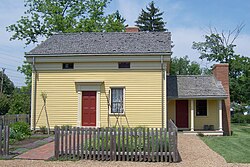Historic Kirtland Village
 From Wikipedia the free encyclopedia
From Wikipedia the free encyclopedia
| Historic Kirtland Village | |
|---|---|
 Newel K. Whitney Home | |
| Location | Kirtland Flats, Kirtland, Lake County, Ohio, |
| Coordinates | 41°37′45″N 81°21′42″W / 41.629185°N 81.361678°W |
| Years of significance | 1831–1838 |
| Restored | 2000–2003, 2022–2023 |
| Governing body | The Church of Jesus Christ of Latter-day Saints |
Historic Kirtland Village is a historic district in Kirtland, Ohio, U.S., owned and operated by the Church of Jesus Christ of Latter-day Saints (LDS Church). The district is made up of buildings and sites important to the early Latter Day Saint movement. Some of the buildings are original and have been restored to their 1830s appearances, while others were rebuilt on or near their original sites. In addition to Historic Kirtland, the church also owns and operates the nearby Kirtland Temple, the Isaac Morley Farm just east of Kirtland in Kirtland Hills, and the John Johnson Farm in Hiram.
History
[edit]The LDS Church purchased the first property in the village, the Newel K. Whitney Store, in the late 1970s, and restored it in 1984.[1][2] In the years since then, the LDS Church acquired more historic buildings and property in the area. In April 2000, plans were announced to restore the remaining buildings, while reconstructing others, building a new visitors center, and rerouting some of the surrounding streets to create a pedestrian-friendly village. Following the completion of the project, LDS Church president Gordon B. Hinckley dedicated the site on May 18, 2003.[3]
In 2018, Historic Kirtland Village exhibited nearly 600 nativity displays from around the world as part of an annual Christmas tradition in its 10th year.[4]
The most recent addition to the village is the Joseph and Emma Smith home, located one block north of the Kirtland Temple. The home, purchased by the church in 2012, was dedicated by David A. Bednar on August 26, 2023, following the completion of a restoration project that began in May 2022 to return the house to its 1830s appearance.[5][6]
List of buildings
[edit]- Visitors' Center
- Newel K. Whitney Store (restored)
- Newel K. Whitney Home (restored)[7]
- Joseph Smith Home (restored)[6]
- John Johnson Inn (rebuilt)
- Schoolhouse (rebuilt)
- Sawmill (rebuilt): Some of the original foundation stones were used in the reconstruction of the sawmill.[8]
- Ashery (rebuilt): Located a hundred yards from the Newel K. Whitney Store and historically a major source of revenue.[8]
See also
[edit]References
[edit]- ^ "Newel K. Whitney Store". Mormon Historic Sites Registry. Mormon Historic Sites Foundation. Retrieved 8 April 2011.
- ^ Anderson, Karl Ricks (2002). "Historic Kirtland Taking Shape". Site & Scene. 4 (1). Mormon Historic Sites Foundation. Retrieved 8 April 2011.
- ^ Shaun D. Stahle (24 May 2003). "Historic Kirtland, Ohio: Once-bustling community restored to 1830s beauty". Church News. Retrieved 8 April 2011.
- ^ Ewinger, James. "Nativity sets from around the world decorate historic Mormon village in Lake County, Ohio", Cleveland Plain Dealer, 12 January 2019. Retrieved on 21 March 2020.
- ^ Toone, Trent (August 24, 2023). "Church prepares to dedicate Joseph and Emma Smith home in historic Kirtland, Ohio". Deseret News. Retrieved August 26, 2023.
- ^ a b "Elder Bednar Dedicates Joseph and Emma Smith's Restored Home in Kirtland, Ohio" (Press release). The Church of Jesus Christ of Latter-day Saints. August 26, 2023. Retrieved August 28, 2023.
- ^ Staker, Mark (2003). "Thou Art the Man: Newel K. Whitney in Ohio". BYU Studies. 42 (1): 74–138. Retrieved 11 October 2017.
- ^ a b Mays, Kenneth. "Picturing history: Sawmill in historic Kirtland, Ohio", Deseret News, 6 June 2017. Retrieved on 21 March 2020.
External links
[edit]![]() Media related to Historic Kirtland Village at Wikimedia Commons
Media related to Historic Kirtland Village at Wikimedia Commons
- Official website
- Kirtland Restoration Project - Mormon Historic Sites Foundation
